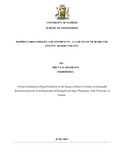| dc.description.abstract | Rapid urbanization is a trend seen across the developing world, with the fastest rates of growth seen in Sub-Saharan Africa. Much of this is due to rural urban migration of people in search of higher education, jobs and or higher standards of living. This is the case of Ruiru town and its surrounding. The trends of urban sprawl appear to be haphazard in Ruiru town with the increase population and better road network. A lot has happened within the last ten years and the impact is hugely felt on land and natural resources. With the population of Ruiru town expected to grow even further, there is need to assess the extent of urban sprawl. The underlying problem in this research was based on the fact that a lot of land in Ruiru town has seen major changes in use and a lot of urbanization activities are witnessed especially along the major roads without development control measures. The main objective of this research was to examine how the application of GIS technology and remote sensing can be used in spatial urban sprawl mapping. Other objectives of the study included; to determine the spatial extent of urban sprawl in Ruiru between 2003 and 2009, 2009 and 2013 and a combined overlay analysis of the ten year impact, to examine the causes and impacts/effects of urban sprawl in Ruiru Sub County with key interest on environment, natural resources and economic indicators and to predict the patterns of future extent of urban sprawl in Ruiru Sub County and give the possible direction of any sprawl chances. To achieve these objectives, a joint approach of non-spatial and spatial techniques was used in the methodology of the study. The pattern of urban sprawl was identified and modelled using remotely sensed data. The analysis in this study included land cover and land use, spatial and temporal changes and urbanization growth pattern recognition as well as non-spatial analysis such as environment and economic indicators. The remote sensing data was then classified for land use, based on themes - built up areas, water bodies, agricultural land and vacant/other land. Change detection was then carried out to determine the spatial extent of the urban sprawl if any. The results showed significant occurrences of urban sprawl specifically 16% urban growth for the period of ten years. Land has been converted to urban use in an increasing rate with future urban growth pointing towards Gatongora Ward where land is available for development. | en_US |

